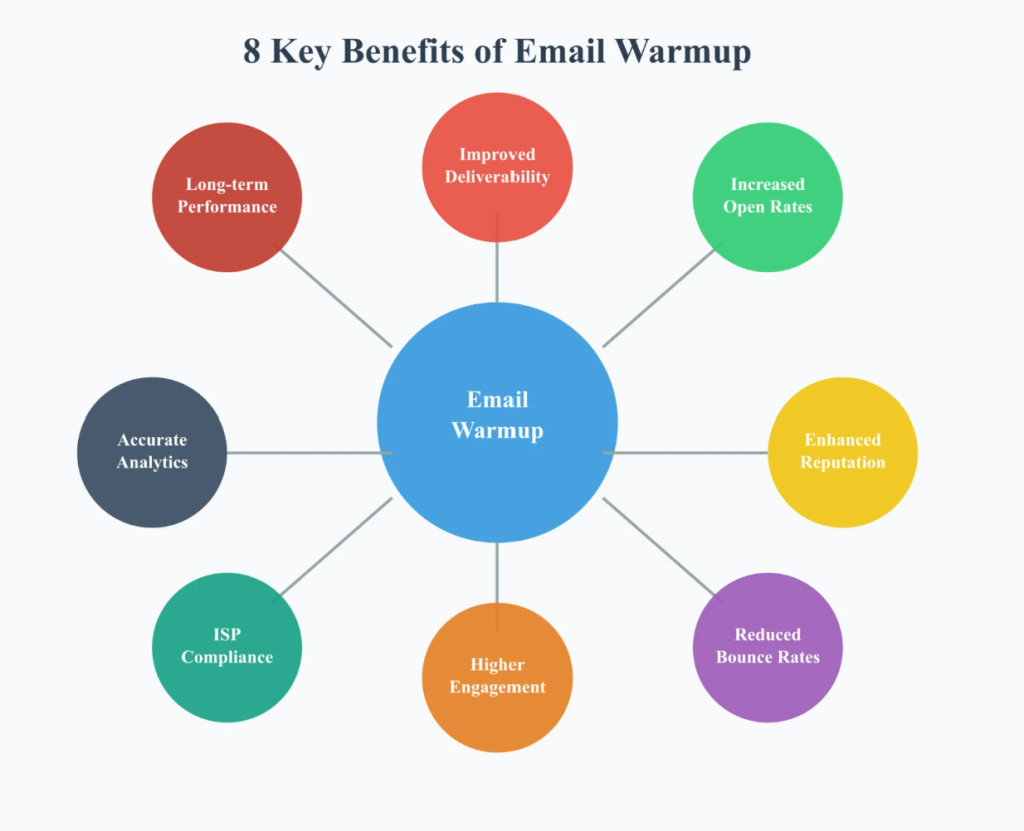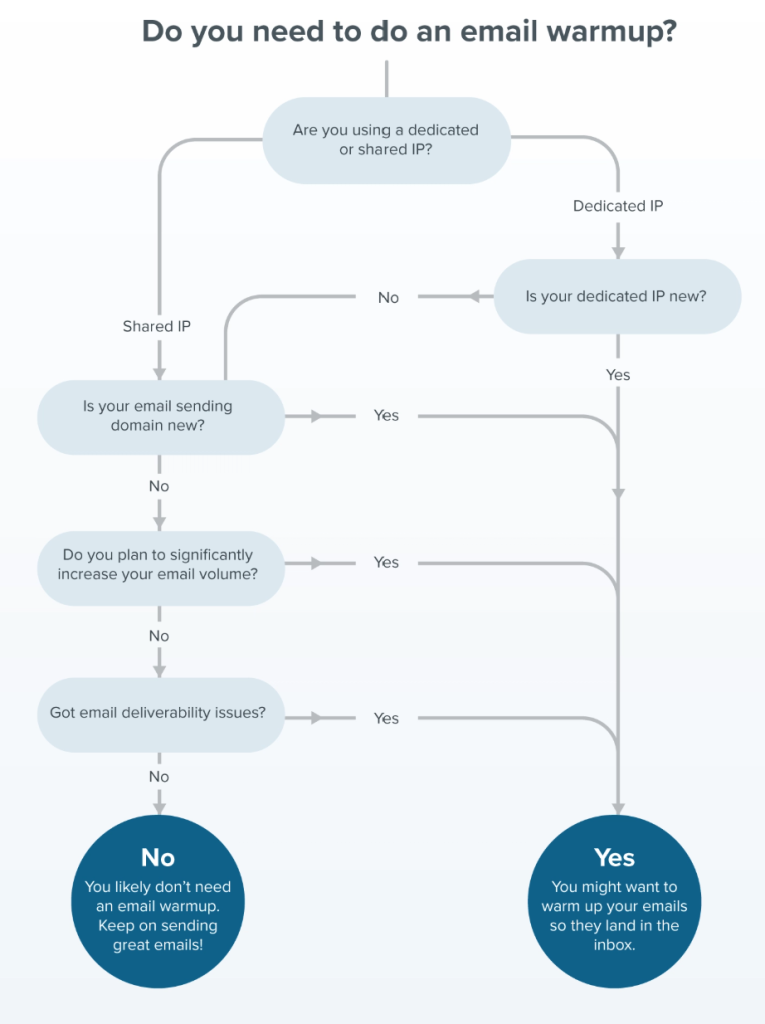- Home
- Fundamentals of Email Marketing
- Is Email Warm-up Only for Cold ...

Do you think email warm-up is just for cold outreach? Then you might want to reconsider and read this article.
Of course, warming up an inbox is a must when you’re reaching out to people who have never even heard of you before. In the end, when you show up completely uninvited in someone’s inbox, email providers will be trying their best to protect the recipient from spam. In other words, they will scrutinize your every email.
But the truth is, warming up emails is much broader than just cold emailing. It is about building sender reputation. In other words, email warm-up is less about who you’re sending to and more about how your sending behavior looks from the outside.
And that’s what we’re going to talk about in this article. We’ll look at why cold email warm-up is so crucial, how to warm up an email domain, and when you can skip it altogether.
Why Email Warm-up Is Crucial for Cold Emailing
👉 No previous relationship with recipients
Cold emails are predominantly vulnerable. This vulnerability comes from the lack of any pre-existing connection between you and your recipients. For email providers this absence of relationship means that they don’t have any basis to interpret your outreach as welcome or at least safe. Quite the opposite: your message is algorithmically processed as a possible intrusion.
In this case, the content of your email, unfortunately, doesn’t matter. Even if it’s the most professional message, written with all the right intentions and full compliance, it won’t help. The only thing that matters here is that your email is unknown.
That’s why, to set the groundwork before any real sending begins, you need a cold email warm-up. The domain warm-up allows you to gradually build up a legitimate sender profile by creating behavioral history and signals that email providers recognize.
👉 High risk of spam flags
Unfortunately, cold emails are often treated similarly to mass-marketed spam, and understandably so. Even when they’re well-intended, they often carry signs that resemble spam: they are unsolicited, often templated, and frequently automated. And from the perspective of email providers, the difference between a personalized cold email campaign and a spam blast isn’t always that obvious.
That’s why it’s critical to understand how spam filters evaluate behavior in the absence of context. They don’t know your intentions and make a judgement based on volume, consistency, interaction patterns, and reputation. So again, it’s your responsibility to create this context first with a domain warm-up.
👉 Essential for building sender reputation
Sender reputation is by far one of the most important assets in email marketing. When it comes to cold outreach, the importance of reputation increases tenfold. So, when people ask, “How do I warm a new email?” they’re really asking, “How do I earn the trust of email systems that have no reason to believe me?”
When you warm up your email domain, you build a sender reputation through gradual action. These actions combined prove to email servers that you are a legitimate sender. A sender reputation gets increasingly more valuable in the age of AI, when email filters are getting smarter and stricter than ever before to spot any lack of compliance with legitimate sending patterns.

Not Just for Cold Outreach: When Warming up Matters Most
While email warm-up is essential for cold outreach, its importance goes far beyond that. In fact, it often becomes even more critical in scenarios that have nothing to do with cold emailing directly. Warming up your domain is firstly and predominantly about maintaining or rebuilding trust.
Let’s look at the most common situations when you still need to warm up, even if you’re not doing cold outreach.
✅ New domains or new inboxes
When you launch a new domain or inbox, it means you are starting from scratch. It also means that at the moment you have zero reputation for email providers. It is nothing personal—they simply don’t know you, and it means they don’t yet have any trust in your activities.
Let’s say you’re planning to launch a campaign that promotes some new products, and you’re using email templates for e-commerce and SaaS that are beautiful, which makes your campaign look good and sound reliable. But even in this case, you need to warm up your domain first. Because, as we already mentioned, regardless of how reliable your campaign looks, it’s all a matter of trust. And by warming up your domain, you create this trust before your campaign lands, which makes its chances for success substantially higher.
✅ Switching email providers or infrastructure
The trick of changing your email service provider or starting to send from a new IP is that your sending history, unfortunately, doesn’t automatically carry over. And here we come again to the trust issues. Because technically, you are now sending from something the inbox providers don’t recognize yet.
In this case, warming up is still necessary because, from the system’s perspective, you’re new again. And this is the case where just email marketing tips aren’t enough—because subject lines, A/B tests, or calls to action won’t matter if you suddenly start sending substantial volumes of emails from a new system.
In this case, a warm-up allows you to restore stability and protect your sender reputation while you’re in transition.

✅ Restarting after a long pause
That’s another case where a warm-up is essential. Because if your domain or inbox has been inactive for several months, it’s no longer seen as reliable—even in cases when you used to have a good track record in the past. Inbox providers are very sensitive to sudden activity spikes after long silences.
That’s why, when you do an email warm-up right, you are reintroducing yourself in a way that email systems trust. And even a short but consistent warm-up can make a big difference in deliverability after a break.
✅ Sending to cold or inactive lists
Reaching out to people who haven’t heard from you in a while comes with the same risks as cold emailing: low engagement and high bounce rates. Email filters treat these messages just as carefully. This becomes even more relevant if your list hygiene hasn’t been perfect.
So, even if you’re not technically doing cold outreach, a short warm-up can significantly improve deliverability.
✅ Deliverability recovery
Warming up can be helpful in such not-so-obvious cases as deliverability recovery. For example, if your past campaigns struggled, warming up can help you rebuild your reputation by gradually sending high-quality, targeted emails to your most engaged users.
So, if you truly want to recover your deliverability, the good news is that it’s never too late. But you will need to put in some effort and make it consistent and intentional. And the first step in this process is having a solid warm-up plan.
When You Don’t Need a Warm-up
While we figured out that a cold email warm-up is crucial for the success of cold email campaigns, not every sender needs to go through a full warm-up process. In fact, if your domain has already built a solid foundation and your sending behavior has been consistent, you may already be in a good position to start outreach without additional warm-up steps.
Let’s see when you can skip it:
🔷 Established domains with regular sending history
If your domain has been active for a while and has a regular email-sending history, then you’re most likely perceived as a trusted sender by most email providers. Your domain has already been introduced to the system, so there’s usually no need to warm up the domain for cold email again. Unless you’ve drastically changed your sending volume or behavior.
That said, even established domains should be cautious. If you’ve been inactive for a long period or are shifting from transactional or newsletter-style emails to cold outreach, some light domain warm-up might still be useful, just to avoid deliverability issues.
🔷 Healthy engagement and list hygiene
If your list is clean and engaged and your open and reply rates are healthy, your sending behavior is already sending the right signals to mailbox providers. In this case, your sender reputation is already being reinforced because you are keeping up with email sending best practices. You don’t need to ask how to warm up emails for cold emailing—because your emails are already interacting with real users and getting good responses.
🔷 Consistent sender behavior over time
The longer you’ve been sending emails from the same domain, the more consistent and trustworthy your domain appears. Since consistency is one of the strongest markers of a reliable sender, it is important to send emails with relatively stable frequency, volume, and content.
When someone asks, “How do I warm a new email?” what they’re really trying to do is build the kind of reliable sending history that email systems can recognize and trust. But if you already have it, there’s no need to start over.
Just make sure you’re not making sudden changes in sending volume, audience type, or content structure. Even strong reputations can be damaged quickly if you drastically shift your behavior.
How Long Does It Typically Take to Complete an Email Warm-up Process?
In most cases, a full warm-up process takes between two and six weeks and depends on several factors, such as your domain age. For example, brand-new domains typically require more time to warm up compared to older, more established ones. It also depends on your sending volume goals, since larger volumes need a longer and more gradual ramp-up than smaller ones. Your starting reputation plays a role too, which means that domains with poor or no reputation need more time to build trust. Using automation tools can also help speed up the process, but even then, it’s important not to rush. What really matters is consistency and monitoring your metrics, such as bounce rates, open rates, and spam complaints, along the way.
Typical warm-up timeline
| Week | Daily volume | Notes |
| Week 1 | 10–20 emails/day | Start low, focus on real engagement |
| Week 2 | 30-50 emails/day | Gradual increase; watch bounce/spam rates |
| Week 3 | 75–100 emails/day | If metrics look good, keep ramping up |
| Week 4+ | 150+ emails/day (if needed) | Full sending volume reached gradually |
To Sum Up
In this article, we talked about why cold email warm-up is so important and looked at different cases when it’s absolutely crucial. Turns out, it’s not just about cold emailing, and the cases where you might need a warm-up are more diverse.
The fundamental thing about email warm-up is that it’s not about cold emailing or restarting after a long pause. It is about trust, the one you need to gain anew or reestablish with email service providers.



